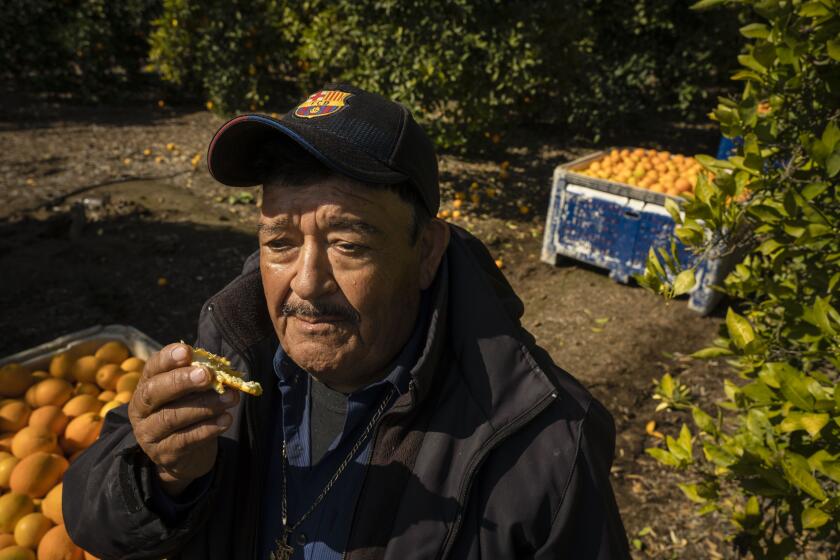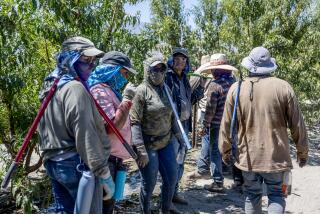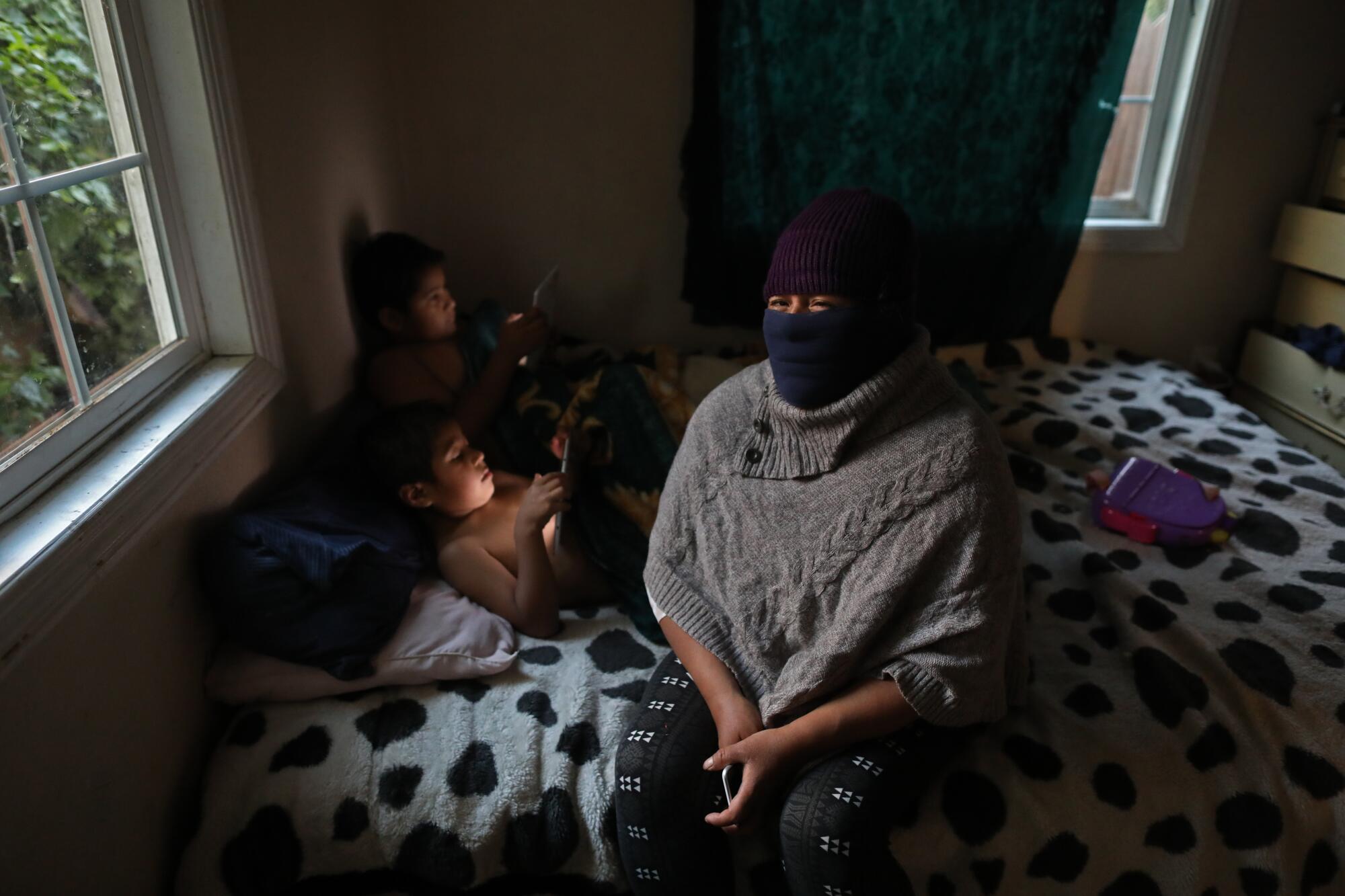
- Share via
SALINAS — A bed fills most of the room that Odilia Leon shares with her five children. In one corner, a dresser spills over with clothes.
For the cramped room in a two-bedroom unit behind a house in east Salinas, she pays $1,050 a month. It’s what she can afford as a fieldworker picking strawberries, her job for the last nine years. A couple with three children rents the other room. In all, 11 people share a living room and kitchen. There is one bathroom.
Every day, Leon, 40, is gripped with fear that she could bring home the coronavirus, infect her children and possibly spread it to the rest of the household. The couple in the other room also works to cover their half of the rent, she said.
“Every time I leave the house in the morning, I worry about how I can come back and hug my kids,” she said on a Thursday evening after arriving home from work.
Social distancing is challenging, if not impossible, in homes like Leon’s and for many other farmworkers in Salinas, the city where John Steinbeck was born. As of Monday afternoon, COVID-19 had infected a reported 751 people in Monterey County, and many of the cases are concentrated on the east side of Salinas, where Leon lives. It is an area that suffers from a lack of affordable housing, with families crammed into homes and renting out whatever space they can, sharing bathrooms, living rooms and kitchens.
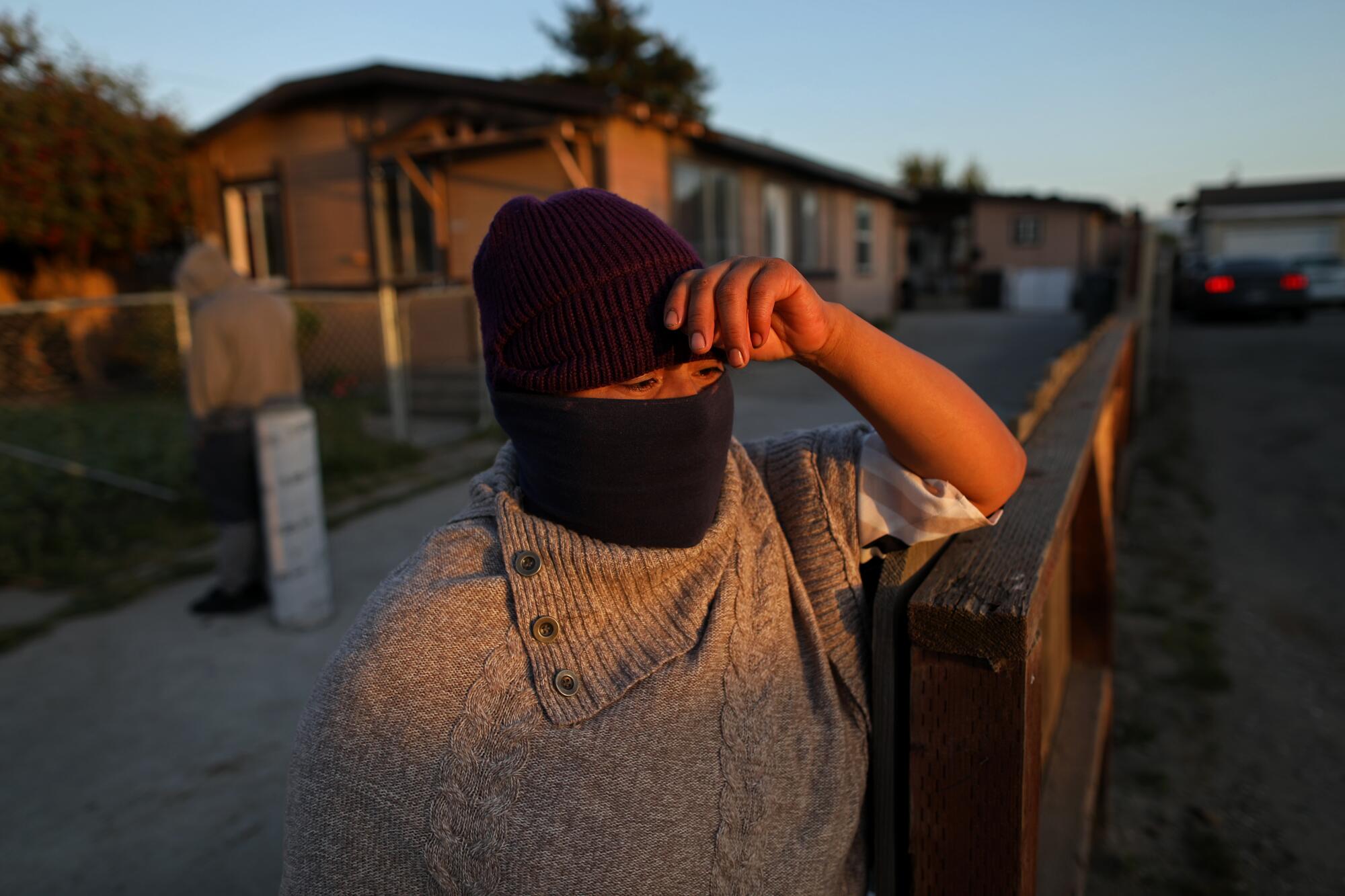
Officials in the Salinas Valley, known as the “salad bowl of the world,” and leaders in the agriculture industry are acutely aware of just how quickly the virus can spread among farmworkers, both at home and at job sites. In Monterey County, agriculture workers make up more than a third of confirmed COVID-19 cases, and Latinos make up nearly 80% of them.
Karen Smith, spokesperson for the Monterey County Health Department, said she does not know if housing is a direct factor, but “if you’ve got people close together with a virus that’s a respiratory virus, you’re bound to see more.”
Dr. Edward Moreno, the county public health officer, has said that the frequency of agriculture workers testing positive is tied with testing being concentrated in places like Salinas, the county’s most populous city.
Monterey County officials were among the first in the state to mandate face coverings at worksites and to ask companies to practice social distancing on buses used to transport workers. The county lobbied the state for masks — receiving 750,000 — and sought alternative housing options for farmworkers and homeless people.
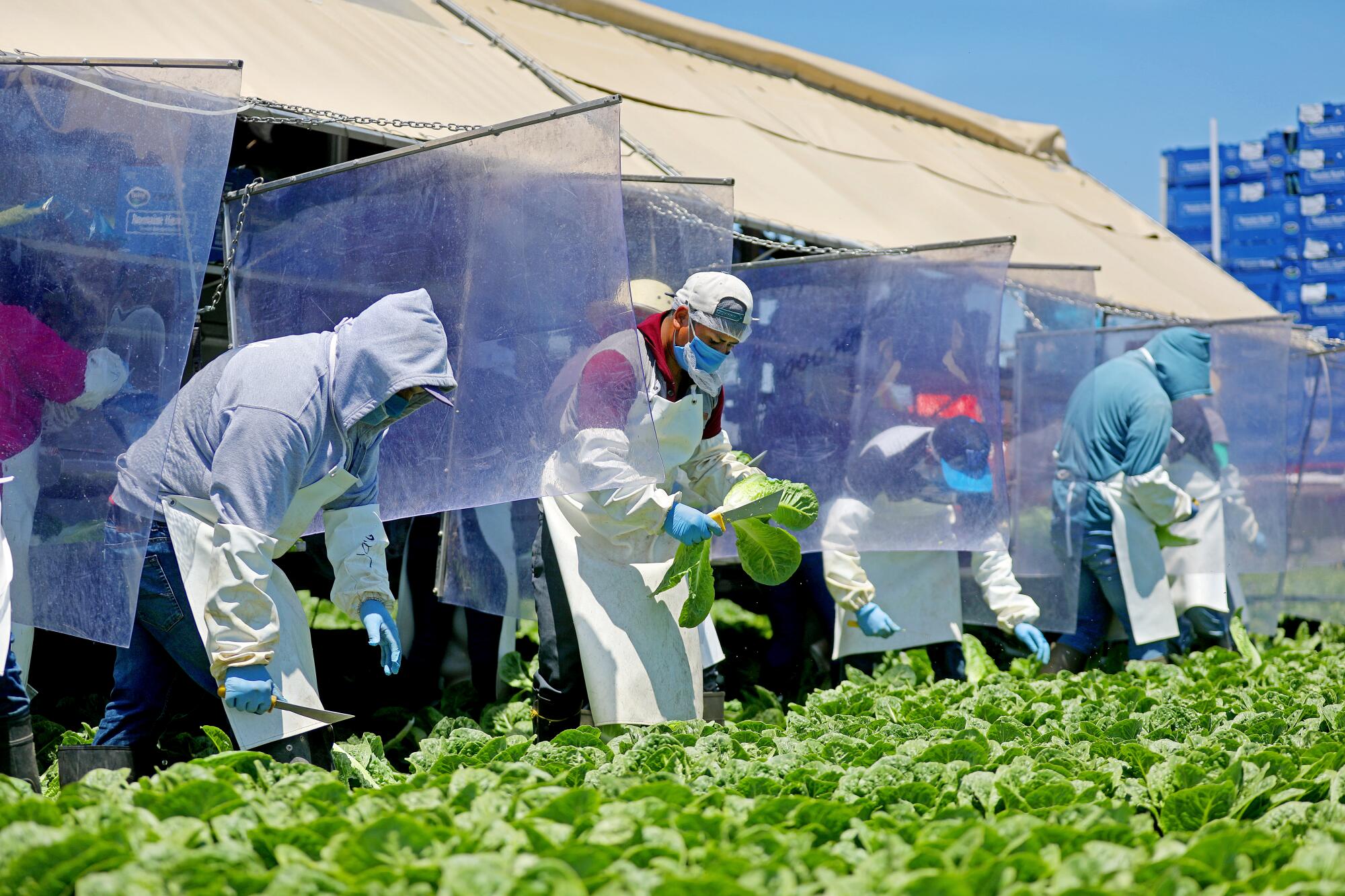
But as the state restarts other sectors of the economy, the agriculture industry, which never stopped because it is considered essential, will continue to struggle with stopping the spread of the virus. The industry is dependent on low-wage labor, people who live in overcrowded housing and poverty. Some, like Leon, have had their hours cut due to the pandemic.
Farmworkers often lack legal status, making them less likely to seek help through official channels, said Monterey County Agricultural Commissioner Henry Gonzales, who worked in the fields when he was younger to pay for college.
California’s 420,000 farmworkers are working through the crisis. But language barriers and a lack of communication on the coronavirus put many at risk.
“Couple that with the crowded housing — it’s a bad situation, and we know it,” Gonzales said. “We can’t prevent it. There’s no way. But what we’re trying to do is minimize it.”
He estimates that there are 45,000 farmworkers who live permanently in the county, and the population could swell to 60,000 as guest workers arrive for the summer to help pick cauliflower, lettuces, strawberries and other produce.
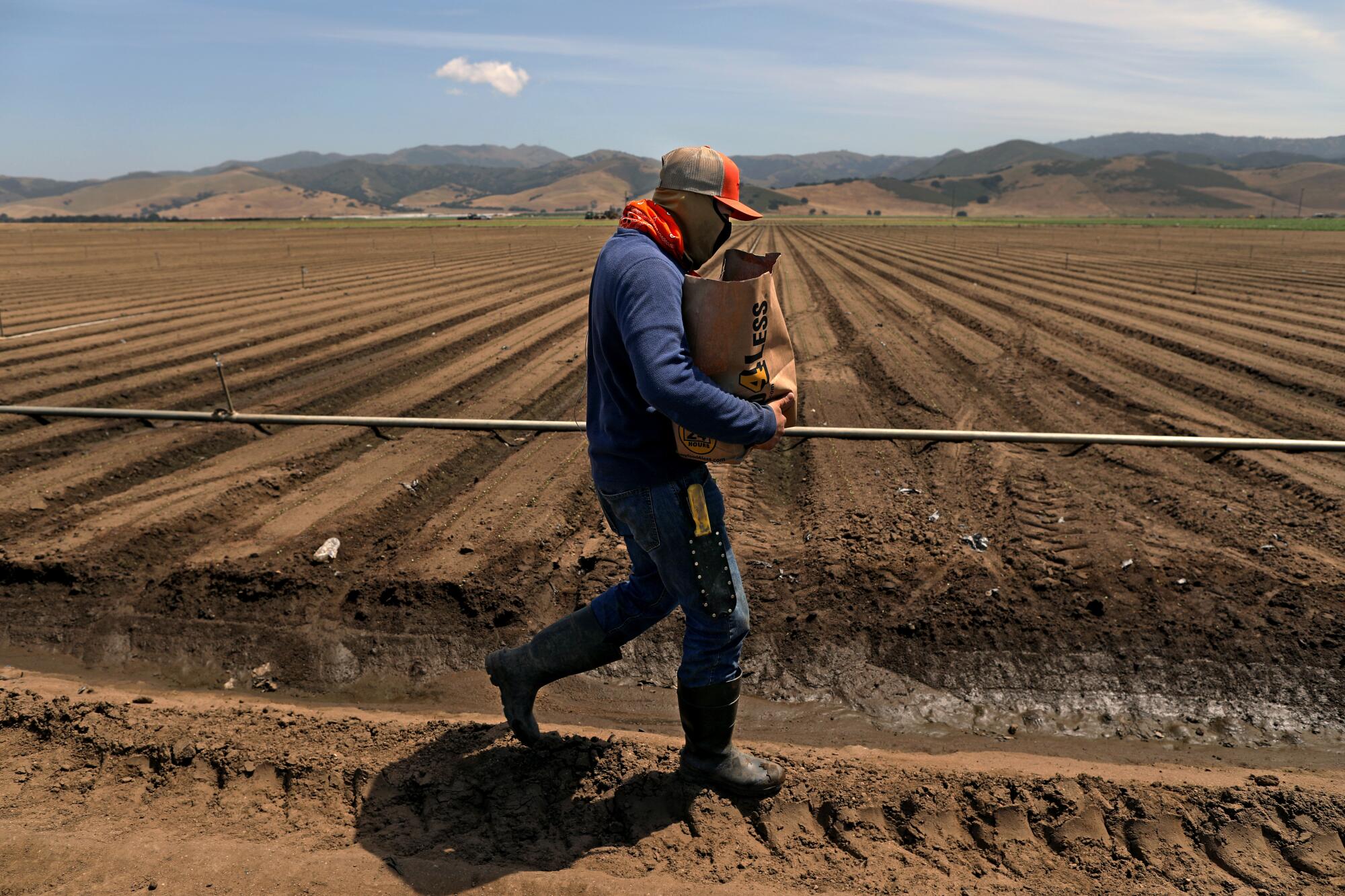
Carissa Purnell, director of the Alisal Family Resource Center, said her organization delivers weekly supplies to farmworkers during their lunch breaks, offering free food, wipes and hand sanitizer, because many can’t afford such items or are too busy working to buy them when they’re in stock.
“A lot of people don’t understand what it’s like,” she said, describing situations in which multiple families squeeze into a single house. “It just breeds the spreading of the virus. There’s no way for it to not be passed around.”
Overcrowding in farmworker housing is severe on the Central Coast. A 2018 study conducted by the California Institute for Rural Studies and California Coalition for Rural Housing found that 45,560 units of farmworker housing are needed in Monterey and Santa Cruz counties. Residences averaged more than seven people, or five people per bathroom, a “stunningly high” rate, the report found.
“Many are overpaying for their housing, living in squalid, substandard homes and/or doubling and tripling up with other households in overcrowded conditions,” the report said.
Maria de los Angeles Jimenez, 29, who works at a salad-packing plant, learned how quickly the virus can spread on May 1, when her feet began to ache. She got tested the next day, and within a few hours learned she was positive for COVID-19.
“I started crying, because I wasn’t expecting it,” she said. She called her brother — who works at a different plant and lives with her — about getting tested. Ultimately, her brother, mother and one of her two sons became sick with COVID-19. They all live together, and she shares a room with her sons, she said; they slept in the living room when she became ill.
Some agriculture companies have spent the past few years building housing for guest workers who come to work under the H-2A visa program, which requires the companies to provide accommodation. In some cases, they have built complexes, rented motels or bought facilities to house employees for a few months in the U.S. before those workers return south, often back to Mexico.
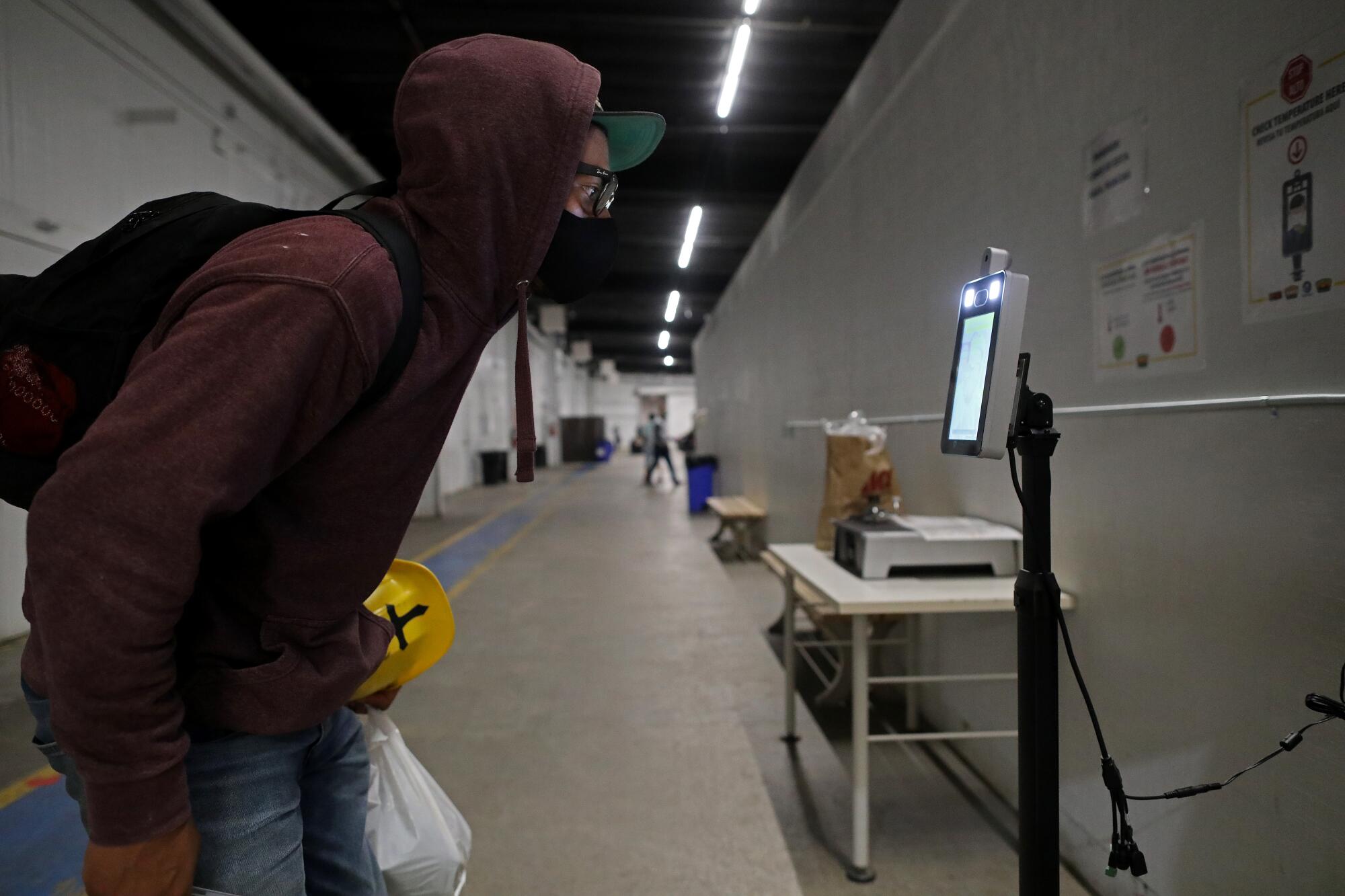
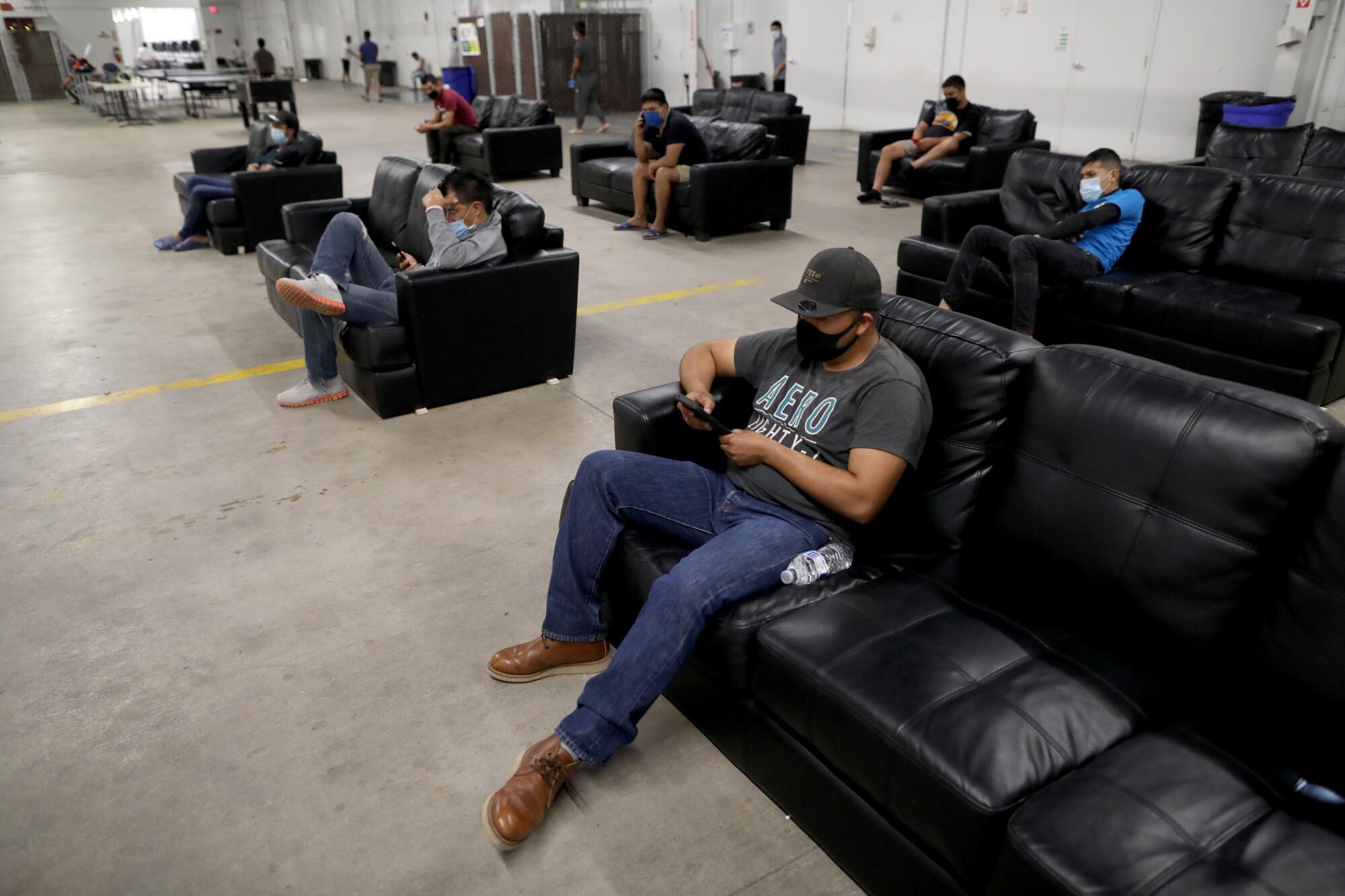
In King City, labor contractor Fresh Harvest houses nearly 300 guest workers in a converted tomato factory. In each dormitory, 17 to 24 workers sleep in bunk beds, lying head-to-toe to create more distance, Linda Rossi, director of communications said.
On a Thursday afternoon, workers finished for the day were distancing in front of a television, one person on each couch, all wearing masks. Some headed to another part of the common area in a line, keeping space between them. In the dining area, where the company has imposed a one-person-per-table policy, a few men sat, each with a pizza box in front of him.
Near the entrance where workers load into buses and head out to the fields, they now pause to have their body temperatures checked by a scanner that resembles a small tablet on a stand. Sometimes they lean down and in until they get the go-ahead: “Your body temperature is normal,” a voice confirms.
The workers get checked twice a day, before they head to work and when they return, Rossi said. Along the walls, signage in Spanish reminds the workers of the symptoms of COVID-19 and guidelines for maintaining distance. So far, no field workers have tested positive for the virus, Rossi said.
“They’re very good about keeping their space,” she said.
On a recent weekday, farmworkers cut, bundled and packaged romaine hearts on a field southeast of Salinas. Plastic vinyl sheets separated the rows of workers to provide a barrier, said David Scaroni, Fresh Harvest’s vice president of operations. Crews are kept together in the dorms to avoid the wide spread of the virus, should an outbreak occur.
Pete Maturino, agricultural director for United Food and Commercial Workers Local 5, said some companies where union members work have made adjustments at work sites to allow for social distancing. But some members come to him about precautions being ignored.
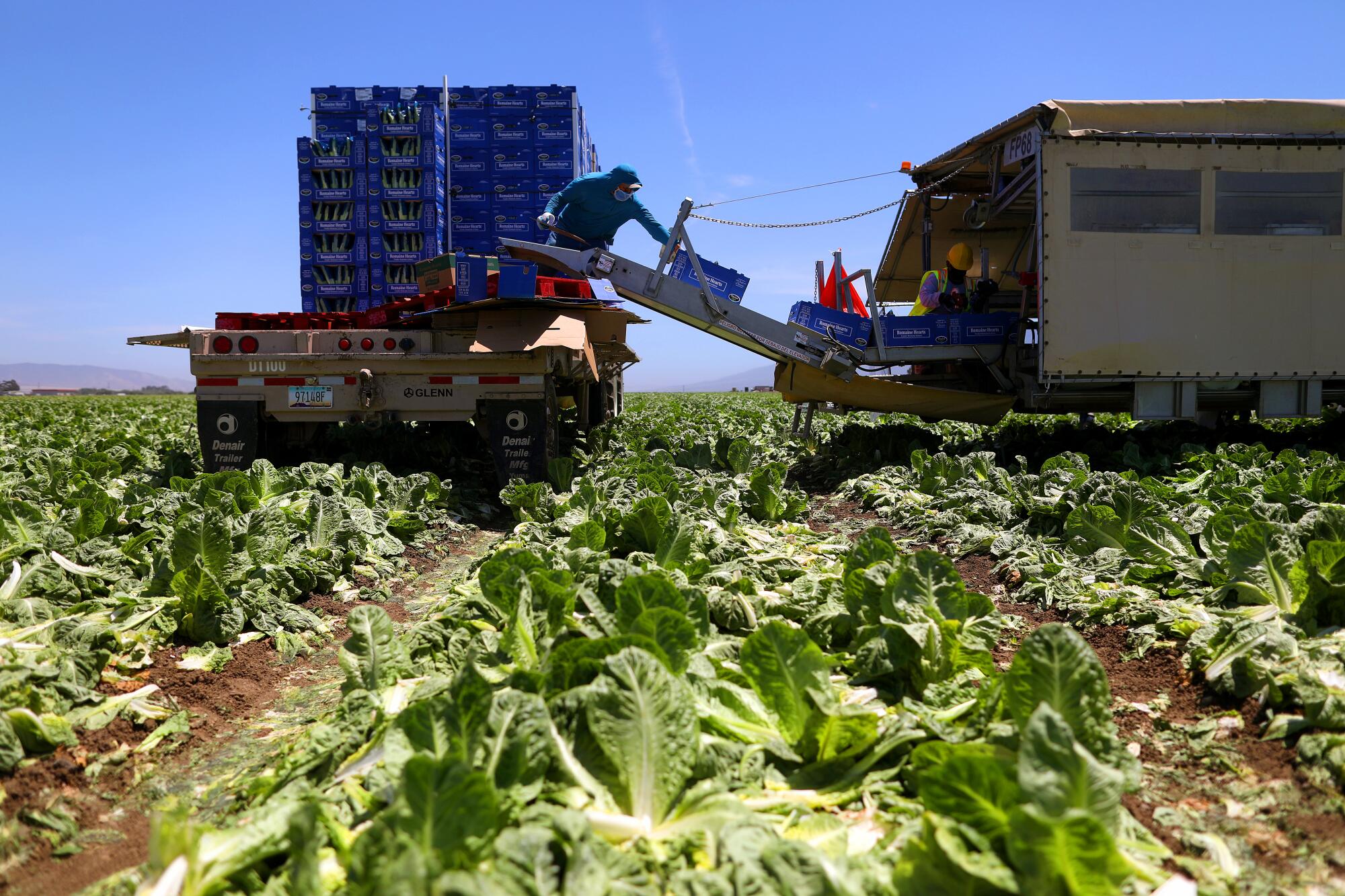
“It matters because that person is going to go home and infect other people,” he said.
The Grower-Shipper Assn. of Central California has reserved hotel rooms to house workers in case they become sick or are suspected of having COVID-19, said Christopher Valadez, president of the industry group. So far, 55 workers have been housed in rooms, a number that fluctuates depending on when a person is cleared to return home, he said.
Monterey County in March requested 100 trailers from the state Office of Emergency Services for use in isolating residents but received just 15. The county Board of Supervisors urgently requested that the state send the rest.
“The county is extremely concerned that we will not be able to sufficiently address the COVID-19 pandemic, especially among our farmworker community, if these additional 85 trailers are not provided by the state,” the supervisors wrote in the letter.
County Supervisor Luis Alejo said that by May, the request had not been met, so the county used its own resources to pay for extra housing to prepare for the worst-case scenario. More than 150 individuals have been housed to date.
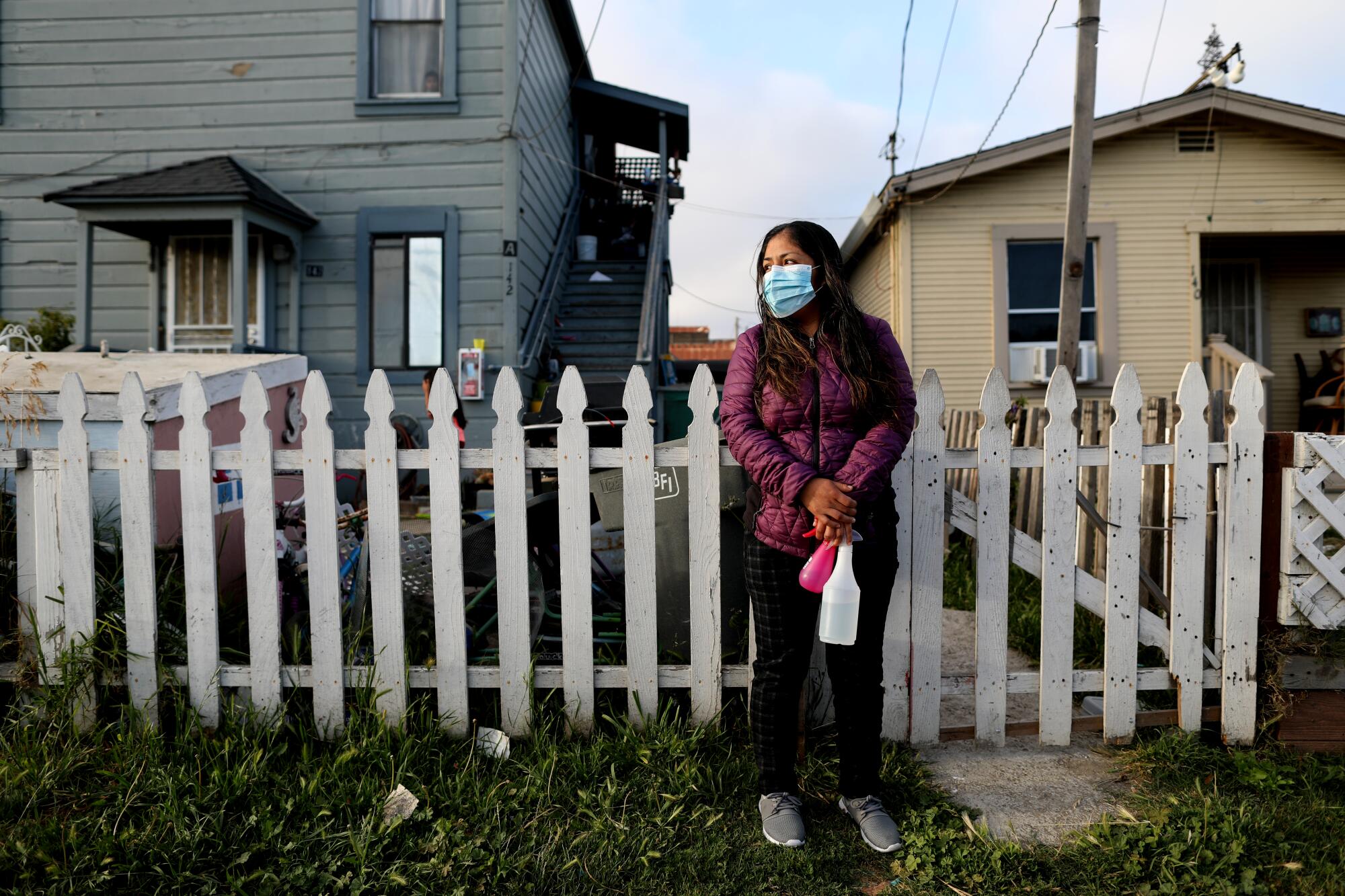
Before Brigida Rivero, 36, started a family with her husband, she lived alone in a home where she rented a room and shared a bathroom with 10 others and worked in the fields. It was uncomfortable to live so close to other people, she said.
“And now, with this illness,” she said, “I think it’s a little worse.”
Rivero, a Salinas resident who works in the fields packing lettuce, takes the coronavirus seriously. She lives with her husband and three children in a small, two-bedroom upstairs apartment. She carries a pink spray bottle, a mixture of water and Clorox, to work to disinfect items. When she arrives home, she sprays the white gate and the banister along the staircase that leads to her front door. She changes out of her clothes before picking up her children from a babysitter.
“In reality, the virus is something no one can see,” she said. “You never know.”
For Leon, the fear of contracting the virus at work has made her anxious. She recently learned that a person who works in her field became ill, but it’s uncertain if it’s the flu or the virus, she said.
If she becomes sick, she’ll use the county’s alternative housing to stay away from her children to keep them safe.
“I would give anything to get back to my children,” she said. “I am the mother and father for them. I have to keep going for them.”
More to Read
Sign up for Essential California
The most important California stories and recommendations in your inbox every morning.
You may occasionally receive promotional content from the Los Angeles Times.
